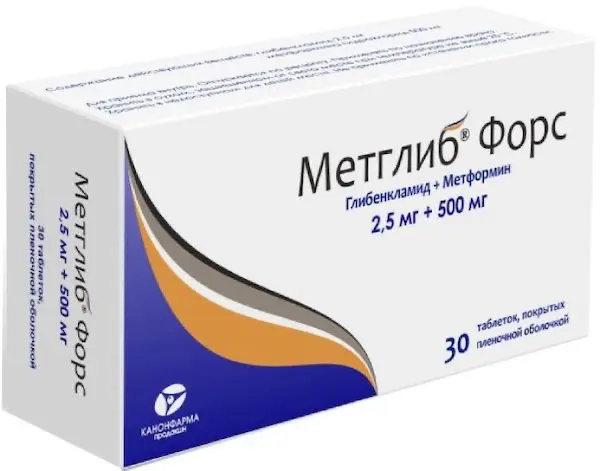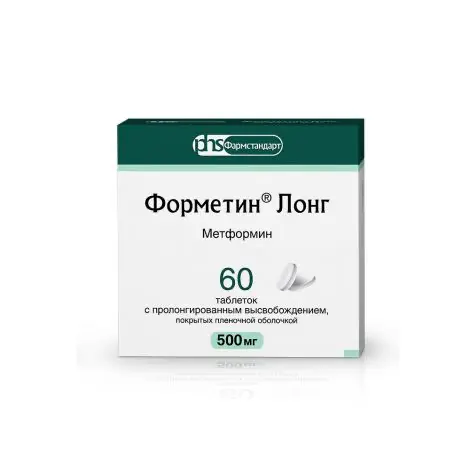Description
Metglyb Force Pharmacodynamics
A fixed combination of two oral hypoglycemic agents of different pharmacological groups: glibenclamide and metformin. Metformin belongs to the group of biguanides and reduces both basal and postprandial plasma glucose. Metformin does not stimulate insulin secretion, and therefore does not cause hypoglycemia. It has 3 mechanisms of action: reduces glucose production by the liver by inhibiting gluconeogenesis and glycogenolysis; increases peripheral receptor sensitivity to insulin, glucose consumption and utilization by cells in the muscle; delays glucose absorption in the gastrointestinal tract (GIT). Stabilizes or reduces body weight in patients with diabetes mellitus.
The drug also has a favorable effect on blood lipid composition, reducing total cholesterol, low-density lipoproteins (LDL) and triglycerides.
Glibenclamide belongs to the group of sulfonylurea derivatives of II generation. Glucose content when taking glibenclamide is reduced as a result of stimulation of insulin secretion by beta-cells of the pancreas. Glibenclamide increases the sensitivity to insulin and the degree of its binding to mice cells, increases the effect of insulin on glucose uptake by muscles and liver, inhibits lipolysis in adipose tissue.
Metformin and glibenclamide have different mechanisms of action, but mutually complement each other’s hypoglycemic activity. The combination of two hypoglycemic agents has a synergistic effect in reducing glucose.
Indications
Type 2 diabetes mellitus in adults:
When diet therapy, exercise therapy, and prior monotherapy with metformin or sulfonylurea derivatives are ineffective;
– for replacement of previous therapy with two drugs (metformin and sulfonylurea derivatives) in patients with stable and well-controlled glycemia levels.
Contraindications
Hypersensitivity to metformin, glibenclamide or other sulfonylurea derivatives or other drug components; type 1 diabetes mellitus; diabetic ketoacidosis, diabetic precoma, diabetic coma; renal failure or renal function impairment (creatinine clearance less than 60 ml/min); acute conditions that may lead to altered renal function Dehydration, severe infection, “Special Instructions”); Acute or chronic conditions that are accompanied by tissue hypoxia: Heart or respiratory failure, recent myocardial infarction; liver failure; porphyria; pregnancy, breastfeeding period; simultaneous use of miconazole; infectious diseases, major surgery, trauma, extensive burns and other conditions requiring insulin therapy; chronic alcoholism, acute alcohol intoxication; lactoacidosis (including. including in anamnesis); observance of hypocaloric diet (less than 1000 kcal/day); children under 18 years old.
It is not recommended to use the drug in persons over 60 years of age who perform heavy physical work, which is associated with increased risk of lactoacidosis in them.
How to use and dosages.
- Inside.
- The dose of the drug is determined by the physician individually for each patient, depending on the level of glycemia.
- The initial dose is 1 tablet of Metglib* Force 2.5 mg + 500 mg or Metglib* Force 5 mg + 500 mg once daily. To avoid hypoglycemia, the starting dose should not exceed the daily dose of glibenclamide (or the equivalent dose of another previously taken
sulfonylurea) or metformin if used as first-line therapy. It is recommended that the dose be increased by no more than 5 mg of glibenclamide + 500 mg of metformin per day every 2 or more weeks to achieve adequate blood glucose control. - Substitution for prior combination therapy with metformin and glibenclamide: The starting dose should not exceed the daily dose of glibenclamide (or equivalent dose of another sulfonylurea drug) and metformin taken previously. Every 2 or more weeks after the start of treatment, the dose of the drug is adjusted according to the level of glycemia.
- The maximum daily dose is 4 tablets of Metglyb* Force 5 mg + 500 mg or 6 tablets of Metglyb* Force 2.5 mg + 500 mg. Dosing regimen:
The dosing regimen depends on the individual prescription: - For 2.5 mg + 500 mg and 5 mg + 500 mg doses
-One time per day, in the morning at breakfast time, when prescribed 1 tablet per day.
-Twice a day, in the morning and evening, when prescribing 2 or 4 tablets a day. - For a dosage of 2.5 mg + 500 mg
-Three times a day, morning, afternoon, and evening, when prescribing 3, 5, or 6 tablets per day. - For a dosage of 5 mg + 500 mg
-Three times a day, morning, afternoon, and evening, when prescribing 3 tablets a day. - The tablets should be taken with meals. Each intake of the drug should be accompanied by a meal high enough in carbohydrates to prevent hypoglycemia.
- Elderly patients
The dose of the drug is selected based on the state of kidney function. The initial dose should not exceed 1 tablet of Metglibh Force 2.5 mg + 500 mg. Renal function should be evaluated regularly. - Children
Metglyb* Force is not recommended for use in children.





